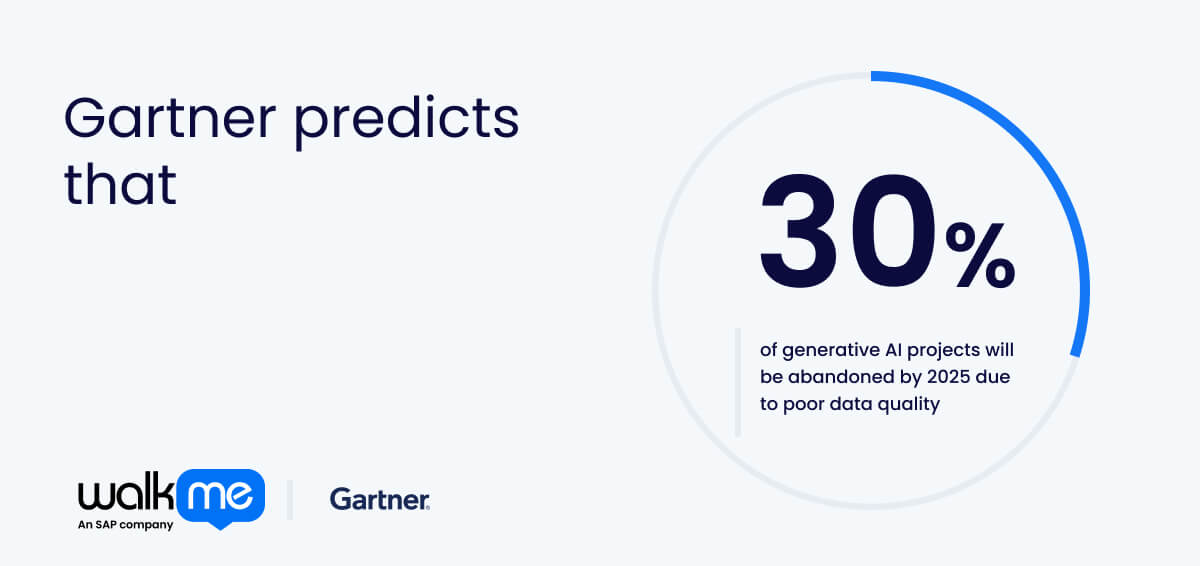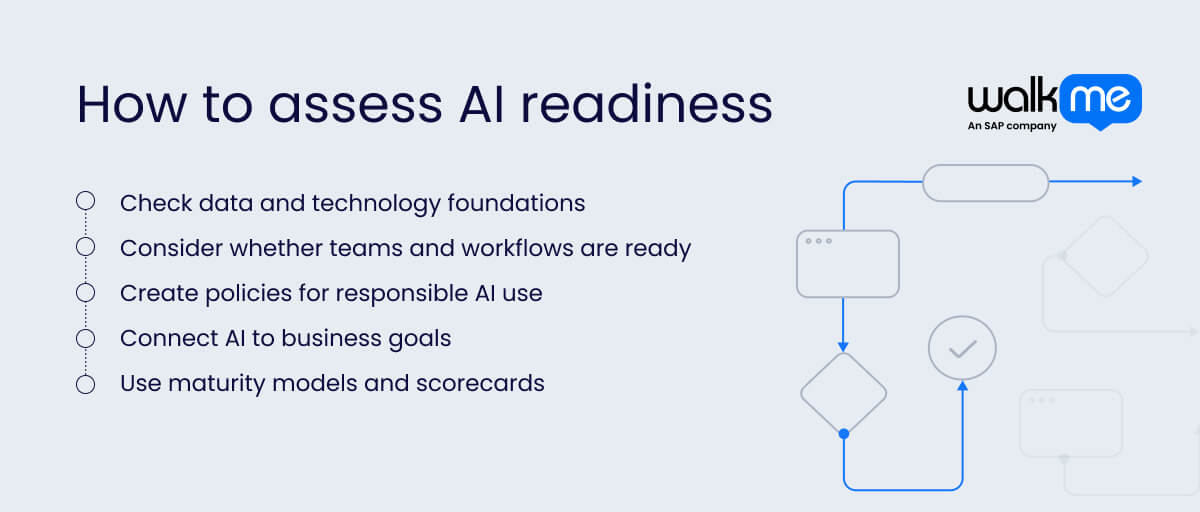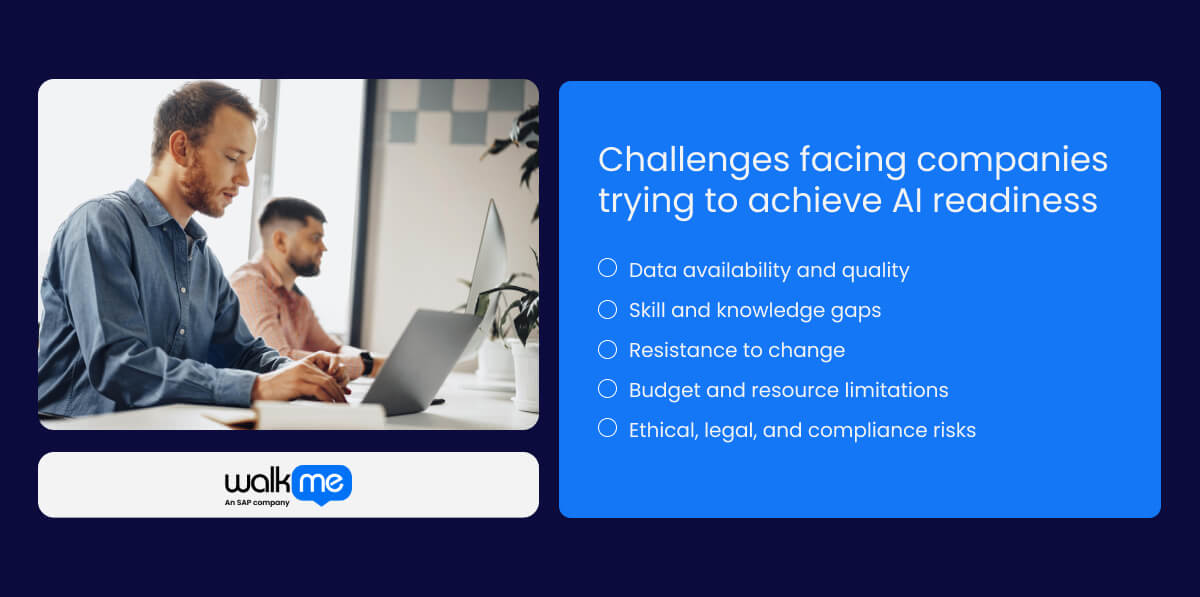What is AI readiness?
AI readiness refers to a business’s preparedness to use artificial intelligence in a manner that yields tangible results. It reveals whether the organization can effectively integrate AI into its everyday operations.

Table of contents
The concept is linked to digital transformation, as it builds on the progress made when a business shifts to more modern ways of working. Over time, AI readiness becomes part of digital maturity as it reflects how data and technology are used to drive smarter decisions and improve performance.
A business with strong AI readiness will have reliable data for use with AI systems, staff who are open to new workflows, and clear direction from leadership about AI business strategy. Examining AI readiness enables a company to identify potential obstacles and address them effectively. For example, they may need to improve data access, planning, or tackle employee resistance.
The current state of data for AI readiness
Deloitte states that data is increasingly important for successful business as it enables artificial intelligence for decision-making and responding to customer needs.
However, AI models cannot perform to a high-quality standard without access to well-organized and accessible data, which is regularly updated and cleaned.
Businesses are encountering data as a key obstacle to their AI readiness. According to Precisely, 76% of businesses surveyed say data-driven decision-making is a top goal for data programs, but 67% don’t trust their data completely.
Unfortunately, Gartner predicts that at least 30% of generative AI projects will be abandoned by 2025 due to poor data quality.

With data quality limiting the potential of AI, organizations need to assess their readiness. Such checks can ensure they lay out comprehensive plans ahead of deploying AI tools.
How to assess AI readiness

Before considering AI, organizations should evaluate their readiness by considering several key components.
There are tools out there to help; many will consider the following factors:
Check data and technology foundations
Strong AI begins with clean and structured data that is regularly updated. Furthermore, infrastructure and software must be properly integrated and scalable to support AI. Without these elements, performance will lag and tools will not deliver value.
Consider whether teams and workflows are ready
Successful AI adoption depends on people and processes, making change management essential. Teams may need support or training to provide reassurance or upskill them. Companies should look for workflows that can be enhanced or automated easily to demonstrate early results.
Create policies for responsible AI use
AI risks must be managed through transparent governance and legal compliance. Ethical standards must also be developed and maintained. Models must be tested and monitored to ensure they comply with regulations such as GDPR, the AI Act, or FTC guidelines.
Connect AI to business goals
Efforts may lack focus or stakeholder buy-in unless they are tied to specific business outcomes. Before implementing AI, the project must be aligned with goals such as increasing productivity or enhancing customer experience.
Use maturity models and scorecards
Frameworks, such as maturity models, help organizations assess their AI readiness across these topics. If they are not yet ready, regularly evaluating can help track progress and establish timelines for deploying AI.
Challenges facing companies trying to achieve AI readiness

Companies must understand the broader implications of deploying AI tools. There may be several obstacles to overcome before they become AI-ready:
Data availability and quality
Creating data management systems is vital to unlock the full value of AI tools. Companies may not realise what is needed to improve existing data, which can lead to delays or the abandonment of projects.
Skill and knowledge gaps
Advanced technical knowledge is required, which may not be available in-house. Once tools are deployed, ongoing monitoring and training are necessary. Employees must be trained on new tools; digital adoption platforms can accelerate the path to proficiency.
Resistance to change
Employees may be resistant to or worried about AI if it is implemented with little warning. McKinsey reveals employees worry about AI inaccuracy and cybersecurity risks. Transparent updates and educating staff throughout the process ensure they will feel positive about change.
Budget and resource limitations
Large investments are required for AI tools and the expertise to support them. Stakeholders may not approve a budget if they don’t understand the value. Demonstrating quick wins and scaling up over time can unlock budget incrementally.
Ethical, legal, and compliance risks
Rolling out AI tools without considering ethical, legal, or regulatory compliance can lead to disaster. Evaluating frameworks and setting up transparent processes is vital. Companies must be accountable for AI governance, ethical data use, explainability, risk management, and have clear roles in place to maintain policies.
AI governance vs AI readiness
AI governance and AI readiness are closely related, but they serve different purposes. Both of them are essential for making AI safe and aligned with business goals. However, they focus on different stages of adoption and use.
- AI readiness is the level of preparation a business has to adopt and apply artificial intelligence in practical ways.
- AI governance is the set of roles and processes that guide how AI is used responsibly within an organization.
| AI Readiness | AI Governance | |
| Purpose | Helps a business prepare to use AI effectively | Sets the rules for safe and ethical AI use |
| Focus | Planning, data, skills, leadership support | Oversight, risk, compliance, accountability |
| Stage | Before and during early adoption | During and after deployment |
| Typical users | Digital leads, data teams, operational managers | Legal teams, compliance officers, executive boards |
Frequently asked questions
Data readiness refers to having clean and organized data that can be easily accessed and utilized by artificial intelligence (AI). To unlock the full value of AI tools, companies must have access to data that is updated and structured appropriately, allowing models to be effectively trained and deployed.
AI improves business operations by automating repetitive tasks and enhancing decision-making with predictive analytics. It can personalize customer interactions and speed up routine workflows to reduce errors. Companies benefit from cost savings, better customer engagement, and enhanced internal operations.
To identify the best AI opportunities for your business, review repetitive processes or tasks that involve a lot of data. Prioritize areas based on those that would be most impacted by AI. Align them with clear business value and measurable outcomes. Consider how AI could save time, reduce costs, or improve customer experience.